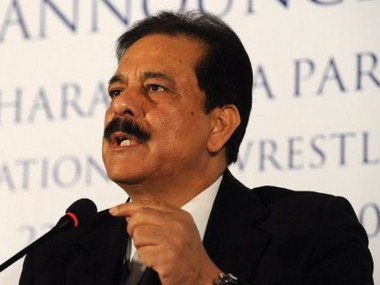The big question being asked about the Sahara group, which has been ordered by Sebi to return over Rs 17,400 crore collected through two dubious issues of optionally fully convertible debentures (OFCDs) in 2008-10, is this: where is the money parked or invested?
In an order dated 23 June, Sebi ordered two Sahara Group companies, Sahara Commodity Services Corporation (SCSC, formerly Sahara India Real Estate Corporation) and Sahara Housing Investment Corporation (SHIC), to return the money raised through OFCDs. OFCDs are bonds convertible into shares at the investor’s option at a future date.
[caption id=“attachment_178930” align=“alignleft” width=“380” caption=“Chairman of Sahara India Subrata Roy Sahara AFP”]  [/caption]
When Sahara, owned by politically well-connected Subrata Roy, moved the Securities Appellate Tribunal against Sebi’s order, it got slapped on the wrist again as the Sebi order was upheld. SAT ordered the two companies to return the money to investors in six weeks.
To buy more time, a desperate Sahara has since moved the Supreme Court, which has set up a three-judge bench headed by Chief Justice SH Kapadia to hear the appeal.
However, Sebi has moved a plea in court to force Sahara to tell it where the money is - whether it has been invested in group companies or related entities. Among other things, Sebi claimed the two companies had diverted the money to Sahara Credit Cooperative Society.
What is clear is that the money raised by the two companies through two controversial issues of OFCDs did go to many group companies - including the Aamby Valley project in Maharashtra.
Impact Shorts
More ShortsAccording to a Business Standard report, Sahara India Real Estate Corporation (SIREC) and Sahara Housing Investment Corporation (SHIC) had a combined exposure of Rs 6,687 crore to the Aamby project, which is actually a complete city project with equally controversial origins and brushes with the law. It is also being investigated by the Enforcement Directorate.
Based on numbers sourced through the Registrar of Companies (RoC), Business Standard says that as at the end of June 2010, the two Sahara firms had raised Rs 16,169 crore - Rs 13,245 crore through SIREC and Rs 2,924 through SHIC, a part of which went to Aamby. The newspaper also speculates whether a part of the money was used to buy out C Sivasankaran’s 49 percent stake in Aamby Valley.
But the RoC figures relate to more than 18 months ago. So the answer to the question - where is the OFCD money is now - is that only Sahara knows.
Of course, on 20 January, the Sebi request for disclosure will be decided on by the Supreme Court.
One thing is certain. Sahara had an inexhaustible appetite for raising money, and, therefore, is needs to come up with a lot of explanations.
When Sebi board member KM Abraham had first forced the two Sahara companies to return the OFCD money, he found several things wrong with their fund-raising methods.
First, the Sahara companies tried to bypass Sebi while making the OFCD issues. Second, they tried to pass off a public issue as a private placement. Third, they planned to keep the issues open indefinitely to raise Rs 20,000 crore in each company. Fourth, Abraham felt that the schemes had a whiff of Ponzi in them - though he did not label them as such. Fifth, the two companies had not complied with even the basics of Sebi’s investor protection rules.
But the sixth fault Sebi found explains all the money jugglery going on between Sahara companies. As _Firstpost_ reported last June , “the group apparently intended to rotate money between one group company and another without reference to investors. The draft red herring prospectuses of both companies state that ’the money not required immediately by the company may be parked/invested inter alia by way of circulating capital with partnership firms or joint ventures or in the fixed deposits of various banks.'”
Observes Abraham in his 23 June order: “This means that such funds mobilised beyond the pale of law could be potentially diverted into various activities of the group companies, without any significant accountability or reporting requirements.”
The Business Standard report confirms this since the money is now partly with Aamby Valley. (For more on the Sahara group’s real estate shenanigans, read this Outlook Business report.) This is the point that Sebi will try to drive home when the matter comes up for hearing on 20 January in the Supreme Court.
Given his political connections, Subrata Roy has lived a charmed life and cocked a snook at two powerful regulators - the Reserve Bank and Sebi have both sent him packing. He has now arrived at his last line of defence - the Supreme Court.


)

)
)
)
)
)
)
)
)



